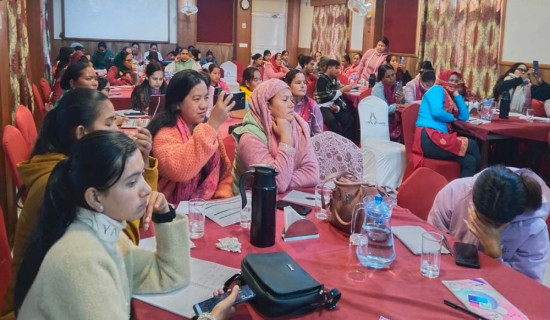- Thursday, 25 December 2025
Menstruation Troubles For Female Teachers
Pushpa Priya
Teaching is a platform where teachers impart knowledge to students. The more knowledge they share the more the student learns. However, sometimes problems pose dilemmas for teachers in teaching. When a teacher happens to be a female, she encounters a special problem - the menstrual cycle during teachings. The menstruation period is not only about a situation of facing bleeding problems but there happened to be both physical and psychological disorders among females which can be perceived mainly in the form of pre-menstrual syndromes such as painful cramps that cause troubles in the teaching and learning process.
Teaching during the menstrual period brings a lot of challenges and difficulties for female teachers mainly in the terms of a patriarchal mindset, a premenstrual syndrome that can be observed in the form of physical pain, and psychological distress. These require an urgency to adopt a unique teaching strategy that comforts the female teachers from the emotional drain and also ensures better teaching and learning.
In the context of Nepal, More challenges greet female teachers while engaging in the teaching during menstruation. In developing countries like Nepal, patriarchal practices are still influenced. We are still confined to some patriarchal mindset.
This practice has negatively affected women and girls who have made their space in the public sphere like teaching. For example, most female teachers in developing countries like Nepal is a victims of discrimination in their home environment. Despite being educated and a job holder, she needs to take sole responsibilities like washing clothes, cooking food, washing dishes, making an appointment with the doctor when children are sick, and earning money for paying tuition fees for children; taking up these responsibilities along with teaching to the students during the menstrual period is very challenging. Another challenge is faced when her internal problem due to hormonal changes are not understood by family members. As the patriarchal mindset expects women to sympathize with the pain of a husband when he is sick and when a wife is sick she is not cared for with love (Brady, 1972). Female teachers also undergo premenstrual syndrome. Premenstrual Syndrome is described as behavioural symptoms affecting both physically and psychologically. The severe form of premenstrual syndrome is called Premenstrual Dysphoric Disorder.
The typical symptoms of premenstrual syndrome normally involve the symptoms like mood swings, anxiety, and irritability. And physical pain symptoms include headache, fatigue, bloating, sleep disturbances, nausea, and breast tenderness. Factors responsible for premenstrual syndrome are Hormonal change, diet and lifestyle. I remain more psychologically affected than physical pain: I become a victim of mood swings.
According to research studies, these kinds of symptoms disappear within four days after the start of the menstrual period. Several theories have been advanced to explain the causes of PMS, but none of these theories has been proven, and specific treatment for PMS still lacks a scientific basis.
And again there is immense pain for most women during menstrual pain through bleeding; and yet they manage their personal, professional and social life. Teaching is considered a job in the public sphere where there is a need to give more energy. In this very context, then things become very difficult to manage for those female teachers who are the victim of premenstrual syndrome.
I also undergo premenstrual syndrome and face different challenges; however, I use to tackle these difficulties of premenstrual syndrome by preparing myself with proper diet, meditation and yoga. Practising these activities helps me in energizing for teaching and learning process. While I go to teach my undergraduate students during such situations, I engage the students in work, group discussion, peer feedback process and sometimes in meditation too. And I prepare these ways of teaching strategies in an organized way beforehand.
There is an urgency to understand the situation of female teachers mainly when they engage in the teaching and learning process during the menstruation period. The physical, emotional or psychological pain of female teachers during such situations must be perceived with care and understanding. There is a need to facilitate them by educational institutions providing leave for one or two days as per the complications they undergo.
Similarly, there is a need to understand female teachers during the menstruation period by their family members too in terms of cooperating in household tasks so that they do not feel tired enough to take classes during such situations. There is an immediate requirement to change the patriarchal mindset. And there should be taken a shared responsibility in the family. Work division may help female teachers with comfort that helps in providing better teaching to the students.
Likewise, government, NGOs and INGOs working for women empowerment must address this problem by generating awareness about pre and post menstruation symptoms among people and educational institutions so those female teachers may be understood in a better way by the educational institutions where they teach and by their family members too.
This would facilitate their better teaching and learning process. If a woman undergoes mood swings during or before the menstrual period, she is often misunderstood by people around her.
In such circumstances, one has to understand the woman since she used to be courteous other times. It is a natural symptom and women should be treated with love and care. Such love would be medicine in her healing process. Love and caring start with family and therefore without delay, there is an urgency to internalize this thing most efficiently. This kind of shared love and care truly helps her feel best for who she is. Love and motivation help in shaping a better career for female teachers.
(The author is an English lecturer)

















